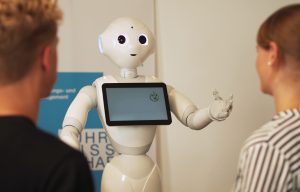News
-
Array ( [0] => March [1] => 10, [2] => 2022 )10March
2022 -
- Executive Education
- leadership
“Robot, leader – or both?” Workshop at the Munich Management Colloquium
Robots have been used for years to increase efficiency or effectiveness in companies, for example in medicine or autonomous driving. Leadership and management tasks, however, still remain with humans – do they? Jakub Cichor started his workshop at the Management Colloquium 2022 for the TUM Institute for LifeLong Learning with this question. He presented current research results from the Technical University of Munich in the area of leadership and robots and discussed with the participants what implications this has for companies, managers and employees.

Cichor is a Research Associate and Doctoral Student in the Neurophysiological Leadership Lab at the Technical University of Munich. His research focuses on technologies in leadership, particularly how social robots can be used as leaders. And so he began by introducing the workshop participants to a leader with a somewhat unusual name: Pepper. Researchers at TUM are using the semi-humanoid robot in their studies. Among other things, they are testing which requirements must be met for robots to be able to take on leadership tasks and under which aspects employees accept non-human bosses as such.
Acceptance gap despite – or because of – human appearance
One important factor: design. “Basically, robots naturally appear more likeable the more human-like they look, for example, if they have some kind of face and limbs. Beyond a certain point of this similarity, however, a kind of acceptance gap sets in. We as observers then suddenly notice the differences from humans in particular, they seem strange, maybe even creepy,” explains Cichor. The Japanese researcher Masahiro Mori coined the term ‘Uncanny Valley’. Cichor recommends that companies dealing with robot executives definitely take this principle to heart.
“Companies should ask themselves with any type of robot they want to deploy: How useful is the robot to the people who work with it? And how easy is it to use?” says Cichor. In the case of managers and leaders, he says, these factors need to be considered with particular sensitivity, and the ways in which they can be used are far from mature, and their success can vary widely. Cichor and his colleagues also observe this in their studies. Among other things, Pepper is programmed to introduce itself to the test subjects, i.e. its “employees,” and to give them a task. The scientists observe whether the processing of the task and the quality of the results change depending on the management style in which Pepper is programmed.
Companies can use research findings for their work

The research findings are highly relevant for companies involved in the social use of robots: “We tend to see that robots programmed for a transformational leadership style are taken more seriously than with other leadership styles, i.e. when the robotic leader displays a kind of charisma. In fact, people develop trust in a robot in a very similar way to a human leader,” Cichor classifies the latest TUM findings. So can robots be leaders? “Yes,” is Cichor’s answer. “But not in all areas. And not yet without human support.”
Those interested in the work of Jakub Cichor and other researchers at TUM’s Chair of Research and Science Management can find more information here. Prof. Dr. Peus, the chair’s holder, is the Founding Director of the TUM Institute for LifeLong Learning – the findings of scientists in her teams are also considered in the development of new programs at the TUM Institute for LifeLong Learning.

